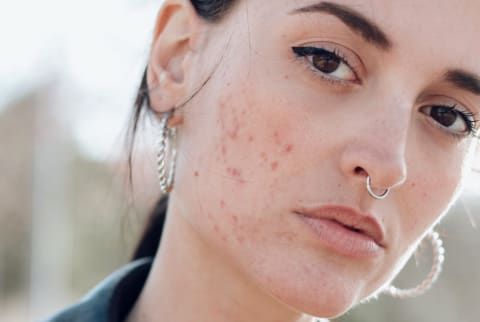Is It Acne Or Rosacea? How To Spot The Difference, According To Derms


When red bumps form on your face, alarm bells may go off in your head that scream: Treat it! Pop it! Dry it out with topicals! You're not alone—we all experience that initial wave of anxiety when an unwanted blemish pops up (that always just happens to appear before an important event or plans to see old friends).
Those pimples you just blasted with a powerful spot treatment? They could very well be signs of rosacea, which requires a way gentler plan of action. Here's how you can tell what your bumps are really telling you.
What is acne or rosacea, and how can you tell what you have?
"Acne is caused by a combination of excess oil production, overgrowth of acne-causing bacteria in the skin, sticky skin cells that block the pores, and inflammation," board-certified dermatologist Joshua Zeichner, M.D., says.
While you can place blame on underlying factors for acne, rosacea typically reacts to the external factors in your life. "The skin is extra sensitive and overly reactive to the environment. Patients typically develop facial redness, flushing, and commonly complain of burning or stinging," Zeichner adds.
When you think of acne, red inflamed bumps may come to mind. But just because you have pimples doesn't mean you have true acne. Those red, inflamed bumps also show up in severe rosacea cases, which is why the two are commonly confused.
"The inflammation caused by rosacea can lead to acne in some patients, called acne rosacea," says board-certified dermatologist Adarsh Vijay Mudgil, M.D. "This is where there is significant overlap, which can understandably lead to confusion."
The distinction is important because the two skin conditions require totally different treatments. While rosacea patients should work on calming the inflammation by avoiding potential triggers (like sun, caffeine, and spicy foods, to highlight a few), acne patients might need to tailor topical treatments depending on the type of bumps they have.
The main kicker is that people with acne develop a combination of blackheads and whiteheads along with those quintessential red bumps and pimples. Rosacea patients, on the other hand, might experience those red bumps, but they won't come to a "head," so to speak.
Here's how you can tell if you're experiencing acne or rosacea:
- You develop blackheads or whiteheads. The main kicker is that people with acne develop a combination of blackheads and whiteheads along with those red bumps and pimples. Rosacea patients, on the other hand, might experience those red bumps, but they won't come to a "head," so to speak. Take it from Zeichner, who says, "Having pimples does not necessarily mean that you have true acne." Looking for those blackheads or whiteheads is key.
- You have facial flushing. Flushing is one of the key signs of rosacea, usually due to environmental influences. Stress, hot beverages, alcohol, and hot weather can all contribute to facial flushing and redness.
- The bumps are in the middle of your face. If your redness remains around the center of your face (think inflammation around your nose and cheeks), that's a good sign it's probably rosacea. While it's definitely not a tell-all, as you can, of course, experience acne in those areas, Zeichner mentions that noticing where you have red bumps can help you categorize your symptoms. "Rosacea patients typically develop facial redness, flushing, and blushing in the middle third of the face," he says.
Ready to treat your skin condition?
Once you've figured out what those red bumps actually mean, it's time to talk treatments. While both conditions can require oral medication in severe cases, it's always a good idea to talk with your derm about the best plan of action for your acne or rosacea (plus, it never hurts to get a second medical opinion on which condition you actually have).
With rosacea, the key is avoiding those obvious environmental triggers that spark your flare-ups, along with gentle cleansers and moisturizers to calm the inflammation. With acne, the road toward clear skin is a little more customized depending on the type of acne you have—whether it's a congested forehead, cystic pimples along the jaw, or a smattering of blemishes along your hairline.
The good news is, identifying which skin condition you have is the first step toward the clear complexion we all crave. So the next time you're feeling anxious about inflamed skin, try not to blindly react; a skin care analysis might do you some good.

Jamie Schneider is the Beauty Editor at mindbodygreen. She has a B.A. in Organizational Studies and English from the University of Michigan, and her work has appeared in Coveteur, The Chill Times, and more. In her role at mbg, she reports on everything from the top beauty industry trends, to the gut-skin connection and the microbiome, to the latest expert makeup hacks. She currently lives in Brooklyn, New York.